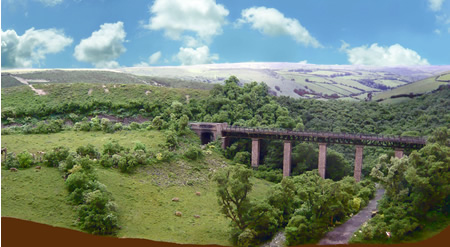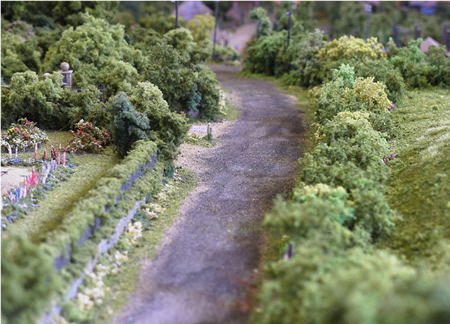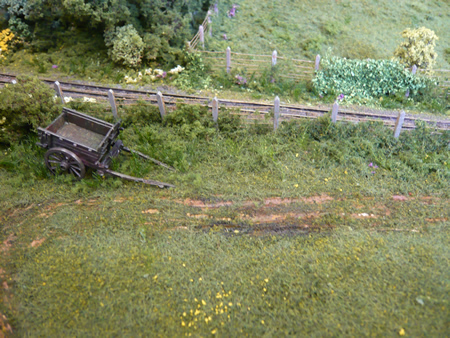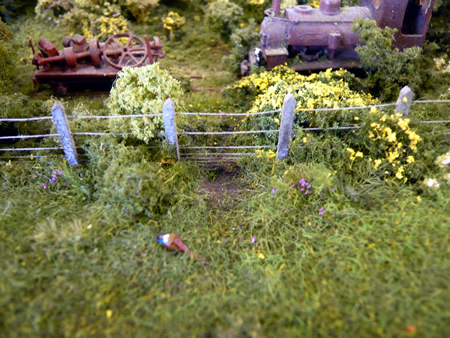|
how to model plants

a little bit of rural
England in 00 scale - Pendon Museum
We have come an awful long way since the days
when model ground was represented by coloured sawdust stuck on the
baseboard with glue. As the model scale increases we can add individual
flowers, proper leaf shapes and even petals!

part of the hotel garden
It
is important to decide what time of the year you are depicting. Should
rhododendrons be in flower....would you have bluebells or cow parsley?
Time of the year will also affect grass and leaf colour. Also check where
one would find certain plants. Foxgloves, for instance like shade.

A field near the station. Elderflower, young
bracken, gorse, red campion and last year's fat hen can be seen
One must remember that flowers planted in
gardens have also changed over the years. Formal gardens of the 1930s are
very different to those we see now. The Royal Horticultural Society can be
very helpful in these matters provided one pays for the membership.

the woodland near the viaduct on County Gate
We have also fixed the compass direction of
the model, as there are great differences between North and South facing
aspects.
County Gate is modelled in early June, so
grass is green and all the trees in leaf. Elderflower is still is full
flower and foxgloves, campion, cow parsley, buttercups and poppies adorn
the landscape. Many folks are surprised how green our model is. For those
who live in Northern Europe, just step outside and take a look! I notice
that some modellers lose confidence when modelling their plants and allow
everything to be faded and yellow. Perhaps that is fine in a dry high
summer but nature is vivid and exciting. I would rather celebrate it.
Gorse can be covered in rich yellow, trees can be in blossom.... Its a
colourful world out there!
Now I have to admit that I really hate
British hedgerows! They often obscure the road and can consequently cause
accidents. However my real hate is that I rather believe that they
represent a huge social statement. They are put there by landowners to
stop us oiks seeing broad horizons....(we might want some of it!).
Recently I drove over a hundred miles and I am convinced it was the same
hedge all the way! How nice to drive in the rest of Europe or the Americas
where one can actually see where one is!
Nevertheless, County Gate has hedges and of
course fences and if they are to look reasonably real a lot of time has to
be spent on them. They say you can tell the age of a hedge by the number
of species found in it. In other words, a lot of work for the modeller.
Again, decide the month you are modelling and don't start unless you have
good photos in front of you.

The hedgerows along the Malmsmead road
Fences also require a lot of attention. If
there are sheep, wool will have stuck on the wires. Often as not, animals
will have excavated a run under the fence somewhere. Look for the details
and bring your layout to life.

The fence along the harbour branch. One
wonders when the cart was last used!

An
animal run (perhaps also small boys) under the fence at County Gate. A
pheasant enjoys the sunshine ignoring Hunslet, the black and white cat
(sitting on the loco) who is feral and lives in the scrap yard. He gets
fed sometimes by the staff.

|